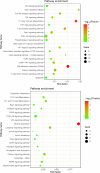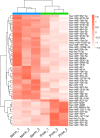Whole transcriptome analysis and construction of gene regulatory networks of granulosa cells from patients with polycystic ovary syndrome (PCOS)
- PMID: 39773546
- PMCID: PMC11706090
- DOI: 10.1186/s40001-024-02237-0
Whole transcriptome analysis and construction of gene regulatory networks of granulosa cells from patients with polycystic ovary syndrome (PCOS)
Abstract
Objective: Polycystic ovary syndrome (PCOS) is a reproductive endocrine disease characterized by reproductive dysfunction and metabolic abnormalities. The purpose of this study was to explore the expression characteristics of coding and non-coding RNAs in granulosa cells of PCOS, and to provide data support for understanding the pathogenesis of PCOS.
Methods: Three patients with PCOS (according to the 2003 Rotterdam diagnostic criteria) and three normal controls were selected. We used the standard long protocol to collect granulosa cells from two groups, who underwent assisted reproduction at the Reproductive Medicine Center of the Affiliated Hospital of Inner Mongolia Medical University, China. We performed whole-transcriptome sequencing using RNA-Seq technology to construct transcriptome patterns of messenger RNAs (mRNAs), long non-coding RNAs (lncRNAs), circular RNAs (circRNAs), and microRNAs (miRNAs). These patterns were then subjected to in-depth analysis using bioinformatics tools.
Results: We identified a total of 2111 mRNAs and 4328 non-coding RNAs (ncRNAs) in the PCOS group as compared with the control group. Among the ncRNAs, there were 2047 lncRNAs, 892 circRNAs, and 1389 miRNAs. Based on the condition |log2(fold_change) |≥ 1 and a P-value of ≤ 0.05, we obtained 705 differentially expressed genes (DEGs), 204 differentially expressed lncRNAs, 111 differentially expressed circRNAs, and 88 differentially expressed miRNAs. The target genes were mainly enriched in metabolic pathways such as mitogen-activated protein kinase (MAPK), Wnt, transforming growth factor-beta (TGF-β), and the cell cycle. There were three types of circRNAs, among which the number of exon-type circRNAs accounted for more than 90%. Using co-expression network analysis, we identified several important candidate gene mRNAs (VLDLR, PPP2R2B, and MYOCD), lncRNAs (FBXO30, SNHG14, and PVT1), and miRNAs (miRNA-150); these mRNAs and ncRNAs could play a regulatory role in PCOS granulosa cells.
Conclusion: In this study, we discovered significant alterations in mRNAs, lncRNAs, circRNAs, and miRNAs in PCOS granulosa cells, indicating dysregulation in vital pathways. Notably, genes like VLDLR, PPP2R2B, and MYOCD, along with lncRNAs FBXO30, SNHG14, and PVT1, may contribute to PCOS pathology, shedding light on potential therapeutic targets.
Keywords: Granulosa cells; Polycystic ovary syndrome; Whole transcriptome sequencing; ceRNA network.
© 2025. The Author(s).
Conflict of interest statement
Declarations. Ethics approval and consent to participate: This study was conducted with approval from the Ethics Committee of Affiliated Hospital of Inner Mongolia Medical University (Approval No. WZ2023048). This study was conducted in accordance with the declaration of Helsinki. Written informed consent was obtained from all participants. Consent for publication: All patients signed a document of informed consent. Competing interests: The authors declare no competing interests.
Figures








Similar articles
-
Construction of a competing endogenous RNA network to identify drug targets against polycystic ovary syndrome.Hum Reprod. 2022 Nov 24;37(12):2856-2866. doi: 10.1093/humrep/deac218. Hum Reprod. 2022. PMID: 36223608
-
Integrated bioinformatics analysis elucidates granulosa cell whole-transcriptome landscape of PCOS in China.J Ovarian Res. 2023 Aug 3;16(1):154. doi: 10.1186/s13048-023-01223-0. J Ovarian Res. 2023. PMID: 37537636 Free PMC article.
-
Identification and Network Construction of mRNAs, miRNAs, lncRNAs, and circRNAs in Sweetpotato (Ipomoea batatas L.) Adventitious Roots Under Salt Stress via Whole-Transcriptome RNA Sequencing.Int J Mol Sci. 2025 Feb 15;26(4):1660. doi: 10.3390/ijms26041660. Int J Mol Sci. 2025. PMID: 40004124 Free PMC article.
-
Non-coding RNAs in polycystic ovary syndrome: a systematic review and meta-analysis.Reprod Biol Endocrinol. 2021 Jan 14;19(1):10. doi: 10.1186/s12958-020-00687-9. Reprod Biol Endocrinol. 2021. PMID: 33446212 Free PMC article.
-
The Role of MicroRNA, Long Non-Coding RNA and Circular RNA in the Pathogenesis of Polycystic Ovary Syndrome: A Literature Review.Int J Mol Sci. 2024 Jan 11;25(2):903. doi: 10.3390/ijms25020903. Int J Mol Sci. 2024. PMID: 38255975 Free PMC article. Review.
Cited by
-
Whole transcriptome sequencing to uncover CircRNA expression patterns linked to schizophrenia pathogenesis.Eur J Med Res. 2025 Jul 15;30(1):626. doi: 10.1186/s40001-025-02899-4. Eur J Med Res. 2025. PMID: 40665444 Free PMC article.
References
-
- Teede HJ, Tay CT, Laven JJE, Dokras A, Moran LJ, Piltonen TT, Costello MF, Boivin J, Redman LM, Boyle JA, Norman RJ, Mousa A, Joham AE. Recommendations from the 2023 international evidence-based guideline for the assessment and management of polycystic ovary syndrome. J Clin Endocrinol Metab. 2023;108(10):2447–69. 10.1210/clinem/dgad463. - PMC - PubMed
-
- Yang R, Li Q, Zhou Z, Qian W, Zhang J, Wu Z, Jin L, Wu X, Zhang C, Zheng B, Tan J, Hao G, Li S, Tian T, Hao Y, Zheng D, Wang Y, Norman RJ, Li R, Liu P, Qiao J. Changes in the prevalence of polycystic ovary syndrome in China over the past decade. Lancet Reg Health West Pac. 2022;31(25): 100494. 10.1016/j.lanwpc.2022.100494. - PMC - PubMed
-
- Du C, Zhao J, Liang L. Construction of miRNA and mRNA expression profiles in granulosa cells from patients with polycystic ovary syndrome. Chin J contraception. 2020;40(04):279–86. 10.3760/CMA.J.CN101441-20190529-00216.
MeSH terms
Substances
Grants and funding
- 2022YFSH0067, 2023KJHZ0038/Science and Technology Planning Project of Inner Mongolia Autonomous Region
- 202202159/Health Science and Technology Program of Inner Mongolia Autonomous Region
- YKD2022MS017/Inner Mongolia Medical University Project
- 2022TD014/Inner Mongolia Autonomous Region Grassland Talent Innovation Talent Team Inner
- 2023NYFYFG005/Mongolia Medical University Affiliated Hospital Youth Backbone Project
LinkOut - more resources
Full Text Sources
Medical

